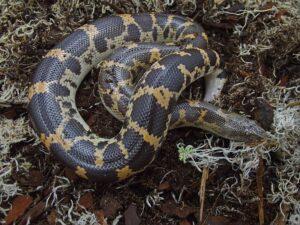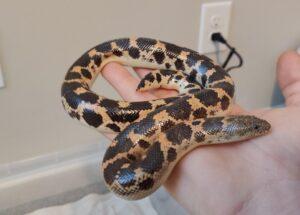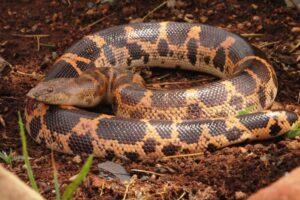Saharan sand boa or West African sand boa is a species or constrictor belonging to the Eryx or Old World sand boa genus. It is native to the African continent.
The species is also known as the Müller’s sand boa in honor of Fritz Müller, the Swiss herpetologist.
Scientific Classifications
- Suborder:Serpentes
- Family:Boidae
- Genus:Eryx
- Species:E. muelleri
Conservation Status
Subspecies
- Eryx muelleri muelleri
- Eryx muelleri subniger
Description
Size
Adults can grow over 2 feet in length.
Color and Appearance
The snakes have a vibrant yellow or orange base color, with dark brown rounded or oval blotches running down the back and sides. The hooklike formation or ‘claw’ at the end of its tail is one of the most important identifying features that help distinguish this species from the more common Kenyan sand boa.
Are they Dangerous to Humans
One of the most docile boa species, the Saharan sand boas pose no danger to humans or pets. They are relatively more active than the Kenyan sand boa but don’t bite or mind being handled. So, they make excellent pets, being a good option for beginners.
Saharan Sand Boa at a Glance
Distribution
African countries, including the Central African Republic, Cameroon, the Ivory Coast, Burkina Faso, Gambia, Chad, Nigeria, Ghana, Senegal, Guinea, Mali, Mauritania, Benin, Sudan, Niger, and Togo
Habitat
Arid and semi-arid regions with loose soil, dunes with vegetative growth, and savannah.
Lifespan
These snakes can live for up to 20 years, especially when kept as pets, and with good care.
Predators
Birds of prey and monitor lizard
Diet
Small rodents, amphibians, and reptiles
Reproduction
Oviparous (egg-laying)
Care Sheet
Size of the Enclosure: A 40-gallon tank would be ideal for a full-grown adult
Temperature: The tank temperature should range between 75°F and 85°F, while the hot spot should be around 95°F.
Humidity: 30-40%
Substrate: 5-7 inches of aspen bedding as they also like to ‘burrow’ in their captive habitat.
Source
cloudfront.net, sareptiles.co.za, reddit.com








